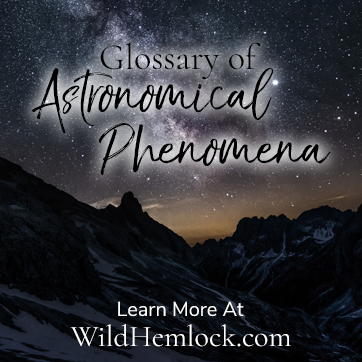
This Glossary of Astronomical Phenomena is designed to be a companion to my Astronomy Calendars and Moon Phase Calendars. With these definitions we can confidently go outside and view the beauty of the universe at night. Most of these events require no telescope or special equipment to enjoy, only good timing and a view of the sky.
Head over to the Astronomy Calendar to find out what is going on tonight, or look at our Monthly Astronomy posts to plan ahead!
Glossary
AAscending Node – An orbital node is the intersection of the celestial ecliptic and the orbital plane of a astronomical body. During an Ascending Node, the orbital body is crossing from the southern to the northern hemisphere of the celestial sphere. This gives the appearance of the object ascending. Eclipses can only occur when the Moon is close to a lunar orbital node [11].
Aphelion – Based on the Greek word for the Sun, helios, aphelion is the position in an object’s orbit where it is the farthest away from the Sun [1].
Apogee – Based on the Greek word for the Earth (Gi), apogee is the position in an object’s orbit where it is the farthest away from the Earth. Typically, it is used for the Moon and other satellites [1].
Annular Solar Eclipse – When a solar eclipse occurs while the moon is closer to its apogee than its perigee, the moon will not be able to completely block the sun. The annular solar eclipse features a ring of sunlight around the dark moon [1] The observer must still be in the Umbra, or direct shadow, of the Moon to observe an Annular Solar Eclipse [9].
Autumnal Equinox – The intersection of the celestial equator and the sun’s ecliptic pathway in it’s southern descent towards the tropic of Capricorn [2]. At this time, the Earth’s axial tilt is facing neither toward nor away from the sun, and there is approximately 12 hours of daylight and nighttime. This marks the beginning of the autumn season in the northern hemisphere [1].
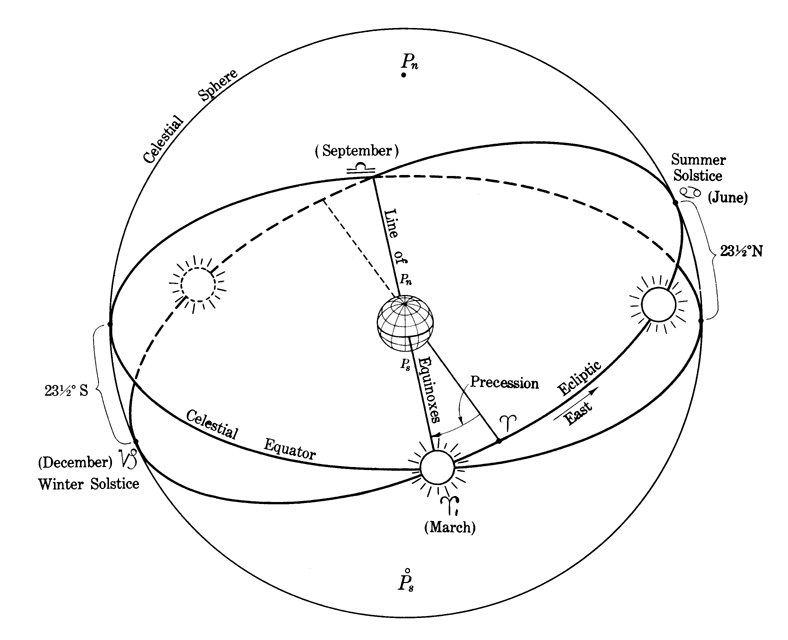
The Celestial Sphere from the US Gov via Wikipedia
BBlack Moon – A Black Moon occurs when there are two New Moons in one calendar month or when there are four New Moons in one astronomical season. Additionally, because the month of February is shorter than a lunar cycle, once every 19 years it will not have a New or Full Moon. These events are also referred to as Black Moons [3].
Blood Moon – A Blood Moon may refer to two different phenomena: a) the discoloration of the Moon during a Total Lunar Eclipse, which is often red, and b) four Total Lunar Eclipses occurring within a time span of two years, approximately every six months (also known as a lunar tetrad) [10].
Blue Moon – In contrast to the Black Moon, a Blue Moon occurs when there are two Full Moons in one calendar month, or four Full Moons in one astronomical season. The latter is called an Astronomical Blue Moon [4].
CConjunction – A planet is in conjunction with the Sun and Earth when the three bodies lie in a straight line. An inferior planet can be at either a Superior or Inferior Conjunction, while a superior planet can only be in Superior Conjunction. The moon, planets, stars, and constellations can all be in Geocentric Conjunction [5].
DDescending Node – An orbital node is the intersection of the celestial ecliptic and the orbital plane of a astronomical body. During a Descending Node, the orbital body is crossing from the northern to the southern hemisphere of the celestial sphere. This gives the appearance of the object descending. Eclipses can only occur when the Moon is close to a lunar orbital node [11].
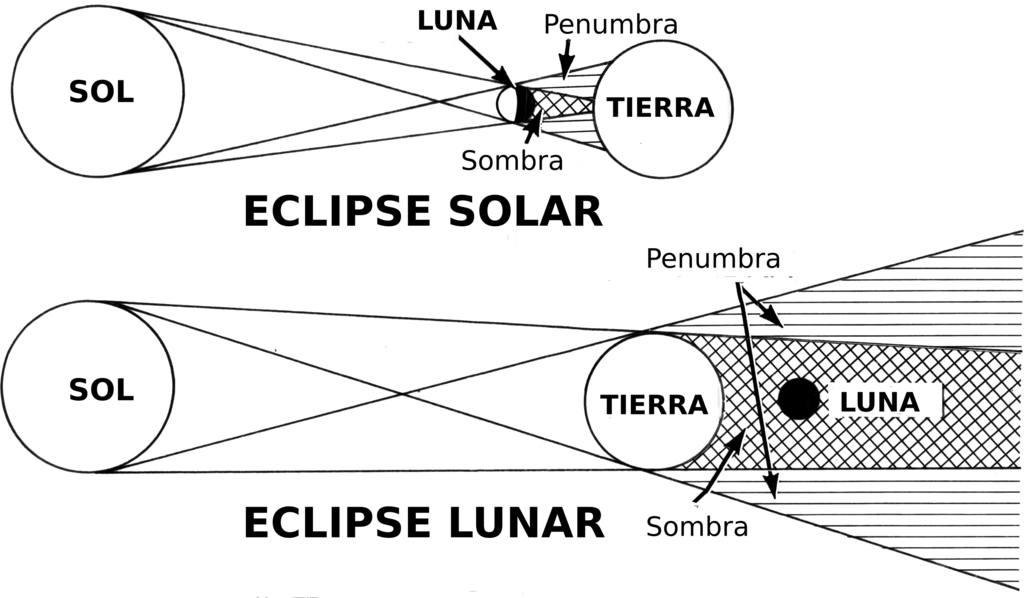
Solar and Lunar Eclipses via Wikipedia
EEclipse – The point in time and space where the Moon either passes directly between the Earth and the Sun (a Solar Eclipse) or opposite the Earth in it’s shadow (a Lunar Eclipse). An eclipse can be total, partial, annular, or penumbral [1].
Equinox – One of two places where the sun’s ecliptic pathway intersects with the celestial equator [2]. At this time, the Earth’s axial tilt is facing neither toward nor away from the sun, and there is approximately 12 hours of daylight and nighttime [1].
FFirst Quarter Moon – After the first one-fourth of the length of the Moon’s cycle, it is at its First Quarter phase. It resides at a perpendicular plane in reference to the Sun and Earth, so the Sun only illuminates about half of the Moon’s surface as viewed from the Earth. The Moon now rises around noon and sets near midnight [1].
Full Moon – The Moon is called Full when the side facing the Earth is completely illuminated by the Sun. This occurs halfway through the lunar cycle when the Moon is on the opposite side of the Sun as viewed from Earth. During this time, the Moon generally rises at dusk and sets at dawn, opposite of the Sun [1].
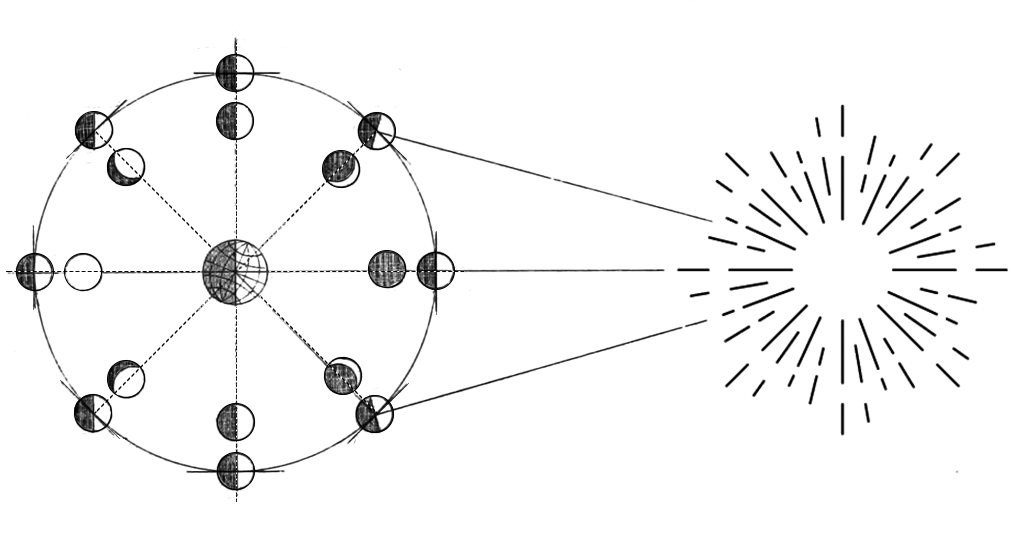
Vintage Diagram of Moon Phases from the British Library, remastered.
The inner circles represent what the Moon looks like to viewers on Earth.
GGeocentric Conjunction – Objects are in Geocentric Conjunction, or Planetary Conjunction, if they appear very close to each other as viewed from Earth. There is no strict definition of how close the objects need to be in order to be considered in conjunction, but generally include objects less than 10 degrees apart as measured in right ascension and declination [5].
IInferior Conjunction – An inferior planet can be in Inferior Conjunction when it, the Sun, and the Earth are in Conjunction in such a way that the planet is between the Sun and the Earth. A superior planet cannot be in Inferior Conjunction [5].

Positional Astronomy via Wikipedia
LLast Quarter Moon – Another name for Third Quarter Moon.
Lunar Cycle – The Lunar Cycle is the cycle of phases the Moon goes through every ~29.5 days as it travels around the Earth and the Earth travels around the Sun. This phenomena is caused by the way that sunlight reflects on the Moon’s surface as the alignment of these three celestial bodies change [1].
Lunar Eclipse – A lunar eclipse is a point at which time the Moon is passing into the shadow created by the Sun and cast by the Earth, so that the Moon is partially or totally shaded [1]. A lunar eclipse can only occur while the Moon is in the Full Moon phase and is located at a lunar node, where the Moon’s orbit intersects with the Earth’s orbit around the sun. This creates a straight alignment, or syzygy [6]. A lunar eclipse can be total, partial, or penumbral.

Lunar Eclipse Diagram from Wikipedia, edited.
MMeteor Shower – Comets and their trailing dust clouds travel around the Sun much like the Earth does. When the Earth crosses those dust streams, a meteor shower occurs. Rocks and dust from these clouds burn up in the Earth’s atmosphere, and can be seen as shooting stars up to 100 per hour or more. Meteor showers are named for the constellation that holds their radiant point, the point in the sky from which the meteors appear to come [1].
Moon Phase – Following the lunar cycle, the moon changes appearance and timing in the night sky. These eight different stages are called Moon Phases. The four main moon phases are New, First Quarter, Full, and Third Quarter. All of the phases in order are New, Waxing Crescent, First Quarter, Waxing Gibbous, Full, Waning Gibbous, Third Quarter, Waning Crescent, and then back to New [1].
NNew Moon – The Moon is in its New Moon Phase at the beginning and end of its lunar cycle. During the New Moon, the Sun’s light is illuminating the side the Moon that cannot be seen from Earth. The Moon is located between the Sun and the Earth is invisible to people there. The Moon rises and sets with the Sun during the New Moon phase [1].
OOccultation – A planet, the Moon, or another celestial body occults a second object when it blocks an observer’s view of the second object (mostly as viewed from Earth). This is most notable during eclipses, but can happen during other phenomena, and is called an occultation. The most common celestial objects that occult others are the Moon, the Earth, other planets, asteroids, and artificial objects like satellites [7].
Opposition – Three objects are said to be in opposition when they are aligned at (approximately) 180°, in a way that the observer is directly between the two objects. Only the superior planets and the Moon can be in opposition with the Earth and the Sun. When the Moon is at opposition, it is at its Full Moon phase. When a superior planet is at opposition, it is an ideal time to view the planet from the earth [8].

Solar Eclipse Diagram from Wikipedia, edited.
PPartial Lunar Eclipse – A Partial Lunar Eclipse is a type of Lunar Eclipse which occurs when the Moon is in between the the Umbra and Penumbra shadows cast by the Earth, as opposed to being entirely within one or the other. These happen when the New Moon close to a Lunar Node, but not enough for a Total Lunar Eclipse. A Partial Lunar Eclipse is partial regardless of the observer’s location on Earth [6].
Partial Solar Eclipse – During a solar eclipse, if both the Earth and the observer on the Earth are not aligned perfectly in the Moon’s Umbra, a Partial Solar Eclipse occurs. These can occur at the same time as Total Solar Eclipse but in a different location on the Earth. If the observer is in the Moon’s Penumbra, it is a Partial Solar Eclipse. These are the most common type of solar eclipses [9].
Penumbral Lunar Eclipse – A Penumbral Lunar Eclipse occurs at a point in time when the Moon is shadowed by the Penumbra cast by the Earth. These happen when the New Moon close to a Lunar Node, but not enough for a Partial Lunar Eclipse. A Penumbral Lunar Eclipse is penumbral regardless of the observer’s location on Earth [6].
Perihelion – Based on the Greek word for the Sun, helios, perihelion is the position in an object’s orbit where it is the closest to the Sun [1].
Perigee – Based on the Greek word for the Earth (Gi), perigee is the position in an object’s orbit where it is the closest to the Earth. Typically, it is used for the Moon and other satellites [1].
Planetary Conjunction – Another name for Geocentric Conjunction.
SSolar Eclipse – A solar eclipse is a point in time in which the Moon is passing in between the Sun and the Earth, blocking the Sun and creating a shadow upon the face of the Earth [1]. A Solar Eclipse can only occur during the New Moon phase. A solar eclipse can be total or partial, or both at the same time, depending on the location on Earth of the observer [9]. An eclipse can be total, partial, or annular [1].
Solstice – One of two places where the sun’s ecliptic pathway across the Earth is at its maximum distance away from the celestial equator [2]. The most direct sunlight (shadows with a 90° angle at noon) is at either the Tropic of Cancer in the northern hemisphere or the Tropic of Capricorn in the southern hemisphere [1].
Summer Solstice – The summer solstice occurs when the Sun and Earth are at Solstice and the Sun’s elliptic pathway is in the observer’s hemisphere. At the same time, the opposite hemisphere is having its winter solstice. During the Summer Solstice, the day is the longest it will be all year. It occurs near June 21st in the northern hemisphere [2] and signals the start of summer [1].
Superior Conjunction – A planet is in Superior Conjunction when it is aligned with the Sun and Earth in such a way that the planet is on the opposite side of the Sun as the Earth. All planets can be in Superior Conjunction [5].
Syzygy – From the Greek word for “being paired together”, syzygy refers to three celestial objects being in one (approximately) straight line. This occurs during transits, eclipses, conjunctions, oppositions, and occultations [6].
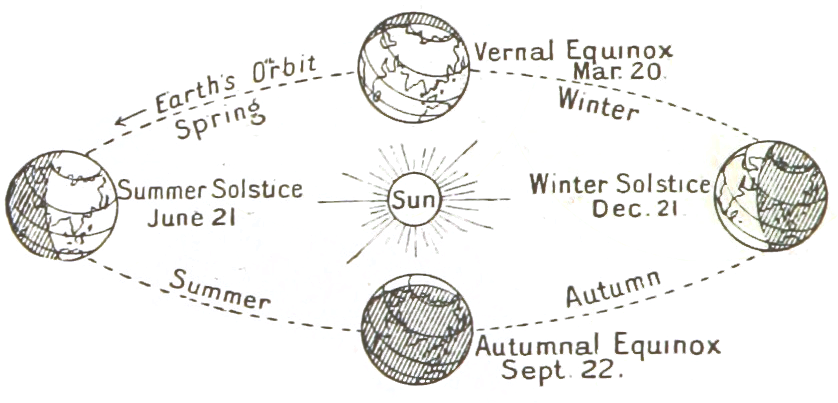
Vintage Diagram of the Earth’s Orbit from the Internet Archive’s Book Images
TThird Quarter Moon – After three-fourths of the Moon’s cycle, it is at its Last Quarter phase. It is now perpendicular to the Sun and Earth, but on the other side as the First Quarter Moon. Again, the Sun only illuminates about half of the Moon’s surface as viewed from the Earth. The Moon now rises around midnight and sets close to noon [1].
Total Lunar Eclipse – A Lunar Eclipse is considered a Total Lunar Eclipse when the following conditions are met: a) the Moon is in the New Moon Phase and close to a Lunar Node, creating a syzygy, and b) the Moon is encapsulated entirely in the Umbra, or direct shadow, of the Earth. A Lunar Eclipse is always either total, partial, or penumbral regardless of the location of the observer on Earth. The Moon will appear red, orange, or brown [6].
Total Solar Eclipse – A Solar Eclipse is considered a Total Solar Eclipse when the following conditions are met: a) the Sun is blocked by the Moon, b) the Moon is close enough to its perigee and therefore appears large enough to completely block out the Sun, and c) the observer is currently in the Umbra, or direct shadow, of the Moon. A total and partial solar eclipse can occur simultaneously to two different observers in two different locations on the Earth, if one is in the Umbra and the other in the Penumbra [9].
Transit – A Transit occurs during an Inferior Conjunction which coincides with a planet’s node, or the time that an inferior planet crosses the Sun’s elliptic pathway. This allows for either Mercury or Venus to cross in front of the Sun between the Sun and the Earth. The Moon can also Transit the Sun. Scientists are discovering exoplanets by measuring them as they Transit across stars outside our solar system [11].
VVernal Equinox – The intersection of the celestial equator and the sun’s ecliptic pathway in it’s northern ascent towards the tropic of Cancer [2]. At this time, the Earth’s axial tilt is facing neither toward nor away from the sun, and there is approximately 12 hours of daylight and nighttime. This marks the beginning of the spring season in the northern hemisphere [1].
WWinter Solstice – The winter solstice occurs when the Sun and Earth are at Solstice and the Sun’s elliptic pathway is not in the observer’s hemisphere. At the same time, the opposite hemisphere is having its summer solstice. During the Winter Solstice, the day is the shortest it will be all year. It occurs near December 21st in the northern hemisphere [2] and signals the start of winter [1].
Do you like WildHemlock.Com?
Support with Paypal!
Sources:
- Fraknoi, Andrew, David Morrison, and Sidney Wolff. Astronomy: A Free Open-Source Textbook. Houston: OpenStax, 2016. 22 Aug. 2019 <http://openstax.org/details/astronomy>.
- “Equinox.” Encyclopædia Britannica, 15 August 2019. <https://www.britannica.com/science/equinox-astronomy>
- “When is the next Black Moon?” Time and Date.com <https://www.timeanddate.com/astronomy/moon/black-moon.html>
- Sharp, Tim. “What is a Blue Moon?” Space.com, 15 November 2018. <https://www.space.com/15455-blue-moon.html>
- “Conjunction (Astronomy)” Encyclopædia Britannica, 5 August 2019. <https://www.britannica.com/science/conjunction-astronomy>
- “What is a Total Lunar Eclipse?” TimeAndDate.com <https://www.timeanddate.com/eclipse/total-lunar-eclipse.html>
- Howell, Elizabeth. “What Is an Occultation?” Space.com, 2 September 2016. <https://www.space.com/33946-occultations.html>
- Levine, Scott. “Word of the Week: Opposition.” EarthSky, 8 July 2019. <https://earthsky.org/astronomy-essentials/what-is-opposition-astronomy>
- “What is a Solar Eclipse?” TimeAndDate.com <https://www.timeanddate.com/eclipse/solar-eclipse.html>
- “What is a Blood Moon?” TimeAndDate.com <https://www.timeanddate.com/eclipse/blood-moon.html>
- “Transit.” Encyclopædia Britannica, 12 May 2016. <https://www.britannica.com/science/transit-astronomy>
- “Node.” Encyclopædia Britannica, Encyclopædia Britannica, Inc., 3 Aug. 2012, <https://www.britannica.com/science/node-astronomy>

